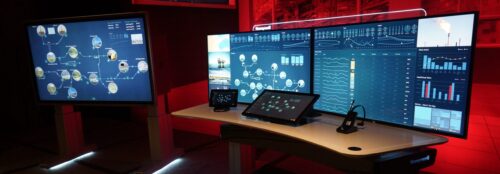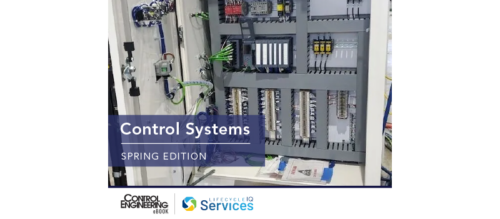Power Monitoring
Powerful reasons for improving electrical services—improvements in quality, reliability, and diagnostics among them—led Merck & Co. Inc. to invest in a power management system at the company’s research and manufacturing facility in Rahway, NJ. Merck, which was named an Energy Partner of the Year by the U.
AT A GLANCE
Power management systems
Electricity measurements
Better efficiencies
Monitoring and diagnostics
Faster test and commissioning
Sidebars: Technology summary: Energy management Better ways to manage energy Other power management systems also save time, energy
Powerful reasons for improving electrical services—improvements in quality, reliability, and diagnostics among them—led Merck & Co. Inc. to invest in a power management system at the company’s research and manufacturing facility in Rahway, NJ. Merck, which was named an Energy Partner of the Year by the U.S. Environmental Protection Agency, has committed to reducing its energy use 25% by the end of 2008. But many advantages to the company are already being felt as a result of the power management system:
Technician time is saved by eliminating scheduled walk-about monitoring.
Automated data gathering is saving time and preventing of data entry errors.
Time for large equipment commissioning tests is reduced from four or five days to two.
Smaller devices are more easily installed.
Faster, more efficient troubleshooting is possible because information is available more quickly, reducing equipment maintenance and downtime.
And that’s just the beginning.
“We’re not utilizing all the information from the system to its full capacity as of yet,” says Dan Fabiani, senior automation engineer, Merck Manufacturing Computer Systems. “We have started crunching anticipated loads and use, garnering savings in energy use.”
Well connected
The project started six years ago at the research-driven pharmaceutical company, which was founded in 1891. With greater attention on energy worldwide, power monitoring advantages seem especially apparent now, as more equipment in the 3,000-employee site has been added or upgraded for use with the supervisory control and data acquisition-type power management system. The SCADA-like tool Merck chose is ABB’s Power Rich System combined with an OSIsoft PI System historian. Fabiani is Merck’s system administrator in charge of the energy management system and powerhouse distributed control system at the facility.
The power system monitors the electrical system at the 100-plus building complex. Some 550 devices are connected to two redundant servers, with approximately 200,000 I/O points currently installed, Fabiani says. More points are added to the system as needed. Connected devices support manufacturing, research, office buildings, warehouse facilities, and powerhouse. The site’s current energy requirements—met by a combination of on-site steam and utility and Merck-generated electricity—come from research, manufacturing, and administrative offices on site. In all Merck processes, the company strives to meet or exceed regulatory requirements and current Good Manufacturing Practices (cGMPs).
Supply and demand
Many electric utilities offer demand-reduction incentives to encourage their customers to save power during times of peak demand. Such arrangements can be far more cost-effective for the utility than buying electricity on the spot market. A facility like Merck’s can optimize energy contracts with energy providers by pinpointing who’s using what power when, Fabiani says. Such knowledge also would allow the site to notify appropriate departments if or when peak-demand reductions are needed. Benefits such as ballast replacement, motion-activated lighting, more efficient motors, and other electricity-saving means also can be applied to most-needed areas first.
With dual 26.4 kV incoming ring buses totaling nine utility feeds for loads up to 480 V, the electricity management system communicates continuously with connected devices, collecting power data such as real, apparent and reactive power; power factor; voltage; current; and waveforms, among other information. Status of all protection and metering devices appears on servers and operator consoles, and alarms go to a supervisor in case an event or failure occurs.
Power sources, in addition to 26.4 kV line feeds, include two 5 MW generators, one 10 MW generator and four 250 kW micro-turbines. These generators, while not enough to supply the whole site with electricity, are sufficient to keep steam production online when there’s a disruption in the electric utility’s supply.
New power generation devices at the Rahway site include a 500 kW, roof-mounted solar energy system installed atop two buildings (including Fabiani’s office, in Building 28) in late 2005. In addition, over the past four years, a 200 kW hydrogen fuel cell has been providing power to Fabiani’s building, making it nearly self-sufficient in generating the electricity it needs, with virtually no greenhouse gas emissions. The Power Rich System continuously monitors and supervises operations of various processes. Some might have been connected to the distributed control system (DCS) for monitoring, but instead were connected to the power management system because of the lower costs of connections. Recent additions include the system’s first few substation-connected wireless I/O points, says Fabiani. A Cisco Systems wireless bridge, specified by Merck IT staff, helped connect a substation across a road, avoiding much more costly trenching of fiber-optic communications. Other recently added equipment includes 5 kV chillers and two cooling towers, which support manufacturing and research.
“The Power Rich system has been reliable over the five-plus years of use at our site,” says Fabiani.
Stephanie Chapman, senior electrical engineer instrumentation and automation, in Merck’s Rahway Utilities Group, says the system’s monitoring functions let technicians be dispatched to resolve problems, rather than just check status and collect information. “We felt we could make our site more reliable by avoiding manual checking. The system removes errors, avoiding the possibility of writing numbers down incorrectly and maximizing use of staff time,” Chapman says. “The monitoring system enables us to accurately collect data now. Power quality is improved, along with reliability and diagnostics.”
As an end-user of the system, Chapman watches over a wide array of connected devices, from varied manufacturers and of various vintages. They include GE Multilin F60, 745, and 489 relays and power quality meters, ABB generator protection unit (GPU) relays, and Sixnet modules, among others.
Device diversity
The main server display shows electrical substations and other loads being monitored, calculating power consumption and other energy parameters for each device and department in the complex. The site map screen shows all monitored components at the highest level. Clicking into each provides more data. At a glance, resources with an active alarm show in yellow (see hypothetical site-map screen).
The initial project connected the majority of devices over a two-year period, including new low- and medium-voltage substations, each tested in the factory and onsite, connected to ring buses and two main feeds. Some relays were replaced; others remain, depending on their functional life. The substations, each built at a different time, differed slightly in design, but installation was the same, except for number of feeders.
System goals included closer monitoring of electricity, which could be used for internal billing at some point or just to enlighten departments about how much energy is used in certain processes. Such measurements will help enable future reductions in energy usage.
Primary and back-up servers are supplemented with four additional client PCs to get information from varied locations, in control rooms and supervisory offices. Monitoring helps with manufacturing line troubleshooting, to see what connected device is down or has lost power, or if there are electrical grid problems. Avoiding downtime extends past manufacturing, Chapman suggests, to quality control with research experiments, where an unplanned outage or upset could result in rework.
With any research and development facility, depending on the nature of the experiment, an outage in electricity, heating, or cooling could cost hours, weeks, or months of rework, delaying product development time.
Easier commissioning
Typically, when new equipment is purchased and installed, a factory acceptance test is performed on the supplier’s site. When the equipment arrives at Merck, it is “tested again, wired according to our standards, and then we do another test,” Chapman says. “We’ll look at the Power Rich screen to compare equipment specifications to status as connected. This makes commissioning much easier, as recently was experienced with the installation of a cooling tower and low-voltage substations to the system,” Chapman adds.
After installation, final testing was condensed to about two days, down from four or five, because of the consistent information and diagnostics available in the power monitoring system. “Because of the way the architecture is set up,” Fabiani adds, “we just need a connection to the plant network to add a new device. That’s the beauty of its remote I/O capabilities.”
Growth
While most connections were phased in within two years, Chapman says, emphasis has shifted from electrical monitoring to overall energy use. More recently, Merck incorporated additional status information from cooling systems and chillers, such as water flow and temperatures, helping ensure reliability, she says.
Most devices run in automatic and are monitored remotely. Yellow on the screen means an alarm. Clicking into the device shows more detail about the alarm and related device. For instance, if a control cabinet overheats on an unusually hot summer day, Chapman says, the source of difficulty quickly can be found, parts obtained, and condensers replaced, if that was the cause.
When there’s an alarm, a technician visits and can switch the device to manual for troubleshooting. To use the remote control capabilities of the Power Rich system, Merck would need to establish related procedures, Fabiani says.
Fuel cell technology
Among Merck’s list of potential future connections to the energy management system is a 200 kW fuel cell. Saying it’s the first U.S. pharmaceutical company to do so, Merck formally dedicated its United Technologies Corp. fuel cell in October 2002 at the 210-acre Rahway site. The fuel cell generates energy equivalent to the demand of 100 typical single-family homes.
The project was the first fuel cell in the New Jersey Clean Energy Program, which helps businesses offset higher capital costs of installing new energy generating equipment using alternative technologies. The U.S. Department of Defense Climate Change Program also helped offset start-up costs for the project. Fuel cells currently cost $1,600 to $4,500 a kW, while fossil-fuel-powered generators can cost as little as $35 kW.
“We operate around the clock and many of our research materials require refrigeration, so a constant, reliable supply of electricity—99.999% free of the possibility of power outages—is critical to our operations,” says former Merck Rahway plant manager Lawrence Naldi, now senior vice president science and technology, Merck Manufacturing Division.
Half-cousins to batteries, fuel cells convert hydrogen and oxygen into electricity, heat, and water in an electrochemical process. There’s no combustion, so virtually no emissions. Since the cell converts fuel (typically hydrogen derived from natural gas) to electricity, fuel cells operate at higher efficiencies than combustion engines, extracting more power from the same amount of fuel. Waste heat is recovered from the process and used for other purposes, creating greater efficiencies. Traditional generating systems produce as much as 25 lb of pollutants to generate 1,000 kWh; the United Technologies Corp. fuel cell produces less than 1 oz.
Vincent Gates, Merck energy manager at Rahway, sees the fuel cell as a sound, innovative alternative technology with great potential. “We tend to forget that petrochemical fuels are finite,” says Gates. Higher efficiencies of fuel cells make better use of these finite resources. UTC Power, a United Technologies subsidiary, currently offers PureCell 200, which produces 200 kW of electricity and up to 925,000 Btu/hr of heat.
In 2007, the Merck Rahway site will undergo additional transitions, including migration of some manufacturing to other locations and startup of new processes, Chapman says. Power monitoring and diagnostics, proven useful to speed commissioning of new equipment, will help during such transitions, she suggests.
Related reading on power management
Other sources at Control Engineering at www.controleng.com contain additional information.
Search power management systems at www.cesuppliersearch.com .
Find system integrators at www.controleng.com/integrators . Refine the search by selecting “power system engr” under “Engineering Specialties.”
“Control Engineering poll asks about impact of energy prices”
“Power Management Helps Your Plant ‘Live Long and Prosper’ ”
“Users Need to Learn More about Power Management”
Technology summary: Energy management
As with any project, end-user involvement early can save time later on.
“Merck was one of the few customers that wanted to get involved in the design phase, which made commissioning easier,” says ABB’s Geoffrey Patton, communications and project engineer, and the designer of the Power Rich system for Merck.
Merck started on the project when Power Rich version 5.21 was available; first installation was 5.41; version 6.0 is now what’s selling, Patton says.
Merck makes use of many of the following features:
System upgrades are offered via a CD installation, and phone-based help can be offered.
Local updates can be propagated through a network using various third-party tools.
Security depends on system setup using standard Microsoft utilities.
Screens have a standard header with user functions such as buttons to return to previous page, help, home, login/out, alarms, time, date, and other functions.
Modbus or Ethernet communications are used at Merck, and the system connects to more than 250 protocols, including ActiveX integration, OPC devices, and PLCs.
The system has multiple device object libraries to ease setup.
Scaleable architecture includes redundancy and means for easy expansion.
Depending on configuration and network configuration, operator screen updates occur in less than 2 seconds.
System support comes from ABB Power T&D Co. Inc. of Lake Mary, FL
Better ways to manage energy
With energy prices as they are, now seemed like a good time to write a book on energy management systems, says industry consultant Bill Lydon. He expects his to be done in fall 2007 and available through ISA Books (
Controls people need to look at processes from an energy-cost standpoint without disrupting production. In many cases, Lydon says, that even can be done through existing control systems, if the systems are attached to the desired areas.
If there’s an automation system in place, data may already exist to do energy management. It’s all what you do with information gathered.
Look at where energy costs are and match input to demand.
Figure cost of energy into unit cost of production
Seek ways to optimize energy content. “If a process requires hot oil, for instance, can you drop the temperature in a standby mode until right before it is needed?” Lydon asks, as an example.
“There’s not much optimization of energy systems going on,” Lydon adds. “I think we’re going to see a lot more.”
Other power management systems also save time, energy
Power management software can gives facility managers quick and easy control over networked uninterruptible power supply systems, power over Ethernet (PoE) midspans, power distribution units (PDUs), rack-monitoring systems, and other networked power components, according to MGE UPS Systems.
Such systems can be accessed via the Internet from any computer with a standard Web browser, show real-time monitoring of networked power systems, and ensure a wide range of quality power protection at a low cost, company says.
MGE’s Enterprise Power Manager v2 can scan for any vendor’s equipment that supports the standard UPS management information base (MIB).
Through its color-coded displays, administrators can activate advanced functions such as automatic shutdown of unattended servers, automatic reboot, and system operation scheduling.
The software works with complex three-phase power systems and can draw any type of power architecture, with multiple levels of redundancy, and view the actual power flows on the graphical user interface.
In dairy processing plants, energy already is 40% of the cost of product, due to a doubling in natural gas prices over the last few years, says Vigilistics, a company serving the dairy and food processing industries with real-time operations intelligence software.
The company’s energy-use analysis software for dairy processing plants looks at energy per unit at various production stages: evaporator, dryer, boiler, refrigeration, and pasteurization, in addition to milk loss reduction and product genealogy tracking and tracing.
“The energy savings opportunity for a dairy plant will generally pay for the Vigilistics energy management system in a few months,” said Ron Huffman, director of operations analysis for Vigilistics.
Do you have experience and expertise with the topics mentioned in this content? You should consider contributing to our CFE Media editorial team and getting the recognition you and your company deserve. Click here to start this process.





